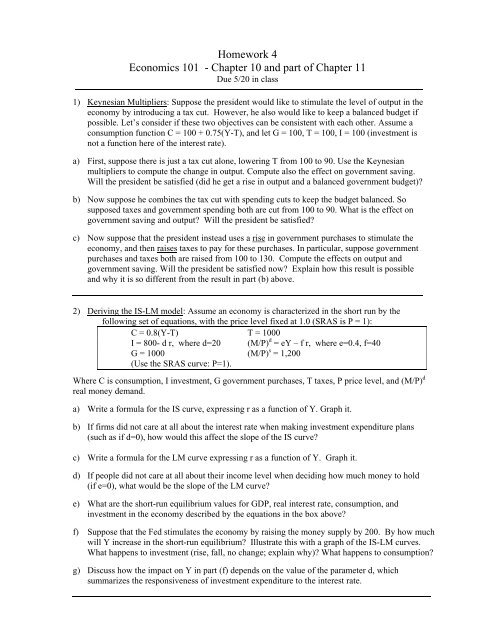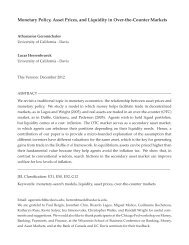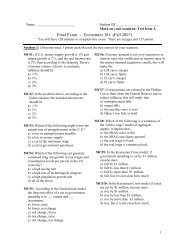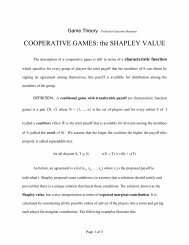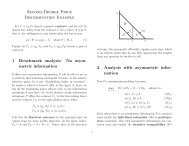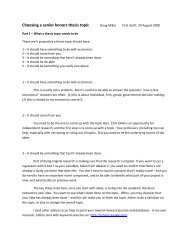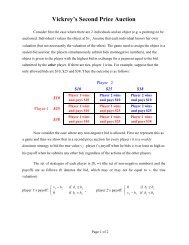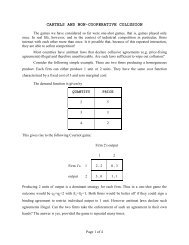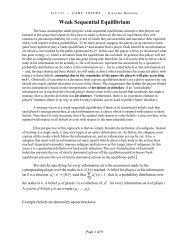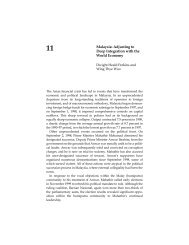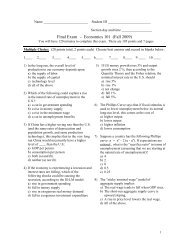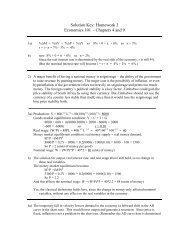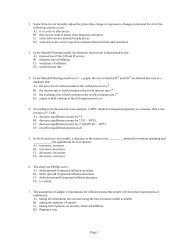Homework 4 Economics 101 - Chapter 10 and part of Chapter 11
Homework 4 Economics 101 - Chapter 10 and part of Chapter 11
Homework 4 Economics 101 - Chapter 10 and part of Chapter 11
You also want an ePaper? Increase the reach of your titles
YUMPU automatically turns print PDFs into web optimized ePapers that Google loves.
<strong>Homework</strong> 4<br />
<strong>Economics</strong> <strong><strong>10</strong>1</strong> - <strong>Chapter</strong> <strong>10</strong> <strong>and</strong> <strong>part</strong> <strong>of</strong> <strong>Chapter</strong> <strong>11</strong><br />
Due 5/20 in class<br />
1) Keynesian Multipliers: Suppose the president would like to stimulate the level <strong>of</strong> output in the<br />
economy by introducing a tax cut. However, he also would like to keep a balanced budget if<br />
possible. Let’s consider if these two objectives can be consistent with each other. Assume a<br />
consumption function C = <strong>10</strong>0 + 0.75(Y-T), <strong>and</strong> let G = <strong>10</strong>0, T = <strong>10</strong>0, I = <strong>10</strong>0 (investment is<br />
not a function here <strong>of</strong> the interest rate).<br />
a) First, suppose there is just a tax cut alone, lowering T from <strong>10</strong>0 to 90. Use the Keynesian<br />
multipliers to compute the change in output. Compute also the effect on government saving.<br />
Will the president be satisfied (did he get a rise in output <strong>and</strong> a balanced government budget)?<br />
b) Now suppose he combines the tax cut with spending cuts to keep the budget balanced. So<br />
supposed taxes <strong>and</strong> government spending both are cut from <strong>10</strong>0 to 90. What is the effect on<br />
government saving <strong>and</strong> output? Will the president be satisfied?<br />
c) Now suppose that the president instead uses a rise in government purchases to stimulate the<br />
economy, <strong>and</strong> then raises taxes to pay for these purchases. In <strong>part</strong>icular, suppose government<br />
purchases <strong>and</strong> taxes both are raised from <strong>10</strong>0 to 130. Compute the effects on output <strong>and</strong><br />
government saving. Will the president be satisfied now? Explain how this result is possible<br />
<strong>and</strong> why it is so different from the result in <strong>part</strong> (b) above.<br />
2) Deriving the IS-LM model: Assume an economy is characterized in the short run by the<br />
following set <strong>of</strong> equations, with the price level fixed at 1.0 (SRAS is P = 1):<br />
C = 0.8(Y-T) T = <strong>10</strong>00<br />
I = 800- d r, where d=20 (M/P) d = eY – f r, where e=0.4, f=40<br />
G = <strong>10</strong>00 (M/P) s = 1,200<br />
(Use the SRAS curve: P=1).<br />
Where C is consumption, I investment, G government purchases, T taxes, P price level, <strong>and</strong> (M/P) d<br />
real money dem<strong>and</strong>.<br />
a) Write a formula for the IS curve, expressing r as a function <strong>of</strong> Y. Graph it.<br />
b) If firms did not care at all about the interest rate when making investment expenditure plans<br />
(such as if d=0), how would this affect the slope <strong>of</strong> the IS curve?<br />
c) Write a formula for the LM curve expressing r as a function <strong>of</strong> Y. Graph it.<br />
d) If people did not care at all about their income level when deciding how much money to hold<br />
(if e=0), what would be the slope <strong>of</strong> the LM curve?<br />
e) What are the short-run equilibrium values for GDP, real interest rate, consumption, <strong>and</strong><br />
investment in the economy described by the equations in the box above?<br />
f) Suppose that the Fed stimulates the economy by raising the money supply by 200. By how much<br />
will Y increase in the short-run equilibrium? Illustrate this with a graph <strong>of</strong> the IS-LM curves.<br />
What happens to investment (rise, fall, no change; explain why)? What happens to consumption?<br />
g) Discuss how the impact on Y in <strong>part</strong> (f) depends on the value <strong>of</strong> the parameter d, which<br />
summarizes the responsiveness <strong>of</strong> investment expenditure to the interest rate.
3) Suppose Congress passes a law for a permanent tax cut.<br />
a) Draw the IS-LM <strong>and</strong> AS-AD graphs to show the short run <strong>and</strong> long run equilibria following<br />
this permanent tax cut.<br />
(Assume that prices are completely fixed in the short run, consumption just depends on<br />
disposable income, <strong>and</strong> investment just responds to the interest rate.)<br />
b) What happens to output, interest rate, investment <strong>and</strong> consumption in the short run?<br />
c) What happens to these variables in the long run? Discuss how this result compares to the<br />
result you got when discussing a similar tax cut for the Neoclassical model in homework #1<br />
(problem #4, <strong>part</strong> b).<br />
5/<strong>10</strong>/13


